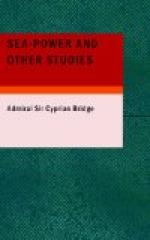[Footnote 22: Schmitz, Hist.Rome_, p. 256.]
[Footnote 23: C. Torr, Rhodesin_Ancient_Times_, p. 40.]
[Footnote 24: Gibbon, Dec.and_Fall_, chaps. xxxvi. xli]
SEA-POWER IN THE MIDDLE AGES
A decisive event, the Mohammedan conquest of Northern Africa from Egypt westwards, is unintelligible until it is seen how great a part sea-power played in effecting it. Purely land expeditions, or expeditions but slightly supported from the sea, had ended in failure. The emperor at Constantinople still had at his disposal a fleet capable of keeping open the communications with his African province. It took the Saracens half a century (647-698 A.D.) to win ’their way along the coast of Africa as far as the Pillars of Hercules’;[25] and, as Gibbon tells us, it was not till the Commander of the Faithful had prepared a great expedition, this time by sea as well as by land, that the Saracenic dominion was definitely established. It has been generally assumed that the Arabian conquerors who, within a few years of his death, spread the faith of Mohammed over vast regions, belonged to an essentially non-maritime race; and little or no stress has been laid on the extent to which they relied on naval support in prosecuting their conquests. In parts of Arabia, however, maritime enterprise was far from non-existent; and when the Mohammedan empire had extended outwards from Mecca and Medina till it embraced the coasts of various seas, the consequences to the neighbouring states were as serious as the rule above mentioned would lead us to expect that they would be. ’With the conquest of Syria and Egypt a long stretch of sea-board had come into the Saracenic power; and the creation and maintenance of a navy for the protection of the maritime ports as well as for meeting the enemy became a matter of vital importance. Great attention was paid to the manning and equipment of the fleet.’[26] At first the fleet was manned by sailors drawn from the Phoenician towns where nautical energy was not yet quite extinct; and later the crews were recruited from Syria, Egypt, and the coasts of Asia Minor. Ships were built at most of the Syrian and Egyptian ports, and also at Obolla and Bushire on the Persian Gulf,’ whilst the mercantile marine and maritime trade were fostered and encouraged. The sea-power thus created was largely artificial. It drooped—as in similar cases—when the special encouragement was withdrawn. ‘In the days of Arabian energy,’ says Hallam, ’Constantinople was twice, in 668 and 716, attacked by great naval armaments.’ The same authority believes that the abandonment of such maritime enterprises by the Saracens may be attributed to the removal of the capital from Damascus to Bagdad. The removal indicated a lessened interest in the affairs of the Mediterranean Sea, which was now left by the administration far behind. ’The Greeks in their turn determined to dispute the command of




